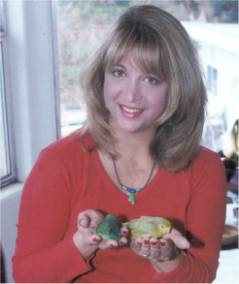I truly thank you for your kind offer to answer questions about Green Rump Parrotlets. You must understand that I’m not an amateur at this sort of thing. I’m 64years old and have been breeding birds of one type or another, off and on for about 55 years. I have worked with everything from pigeons and poultry to endangered species of South America. As a matter of fact, when I was living down there in Paramaribo, Suriname, I was seriously working with Purple Honeycreepers (or as they were called there, Yellow-legged Honeycreepers) and several types of Oryzoborus and Sporophila (Seedeaters), Euphonias and not so seriously with some macaws and parrots.
One Saturday while doing the weekly shopping for the family, I came upon an Indian boy selling birds on the sidewalk. The little green parrotlets were fascinating. I asked what they were called and was told they were Guianese Parrotlets. He said, I could identify the males and females by coloring. So I picked a male and a female, and paid the boy about 2 to 3 dollars(US) for the pair. Dump luck prevailed and the pair were on eggs in about 6 weeks. I was seriously working with the other species I had and only bought the Green Rumps because they were cute. I gave them no effort and so it was surely dumb luck.
This time I do not want to rely on dumb luck. I want to know what to do in case the pair I bought three weeks ago are not as willing to reproduce as the wild birds I bought 18 years ago. I have read the things you posted on the web site and think I have a good feel for what is required of me, but still have a few questions. So please allow me to ask the few I still have:
(1) First; in your "Breeding Parrotlets", when you say "Blue Wing" several times, are you referring to Forpus xanthopterygius, rather than the "Blue Winged Parakeet" listed as an alternate name for the Green Rump?
(2) Do you recommend plants (artificial or live) around the cage to create an atmosphere of isolation?
(3) What size nest box is best? The pair I had in Suriname used a deep box (about 6" x 6" x 14").
(4) I have read you suggestions on diet and have but one Question. Is there any fruit or vegies I should not offer? I once lost a pair of Euphonias feeding a fruit that was not native to South America.
(5) The pair I bought appear to be young, and I did not get their age from the seller. Is there any way to tell when they are about a year old?
(6) And finally, how long is incubation?
Well, that is enough for now. I'm sure I will have more questions at some later date. But I just want to do it right this time. And I want to thank you in advance of your answering.
1) I am indeed referring to Forpus xanthopterygius not the erroneous name of Blue Winged Parakeet. Although I do mention Blue Winged Parakeets in my latest book as a previous name for Green Rumps, it is for reference only. The genus of Forpus parrotlets were once called South American lovebirds at one time as well but the nomenclature has changed to correctly identify the birds. Both terms are archaic and incorrect as the birds are neither parakeets nor love birds but true South American parrots, of course.
2) I do not use plants in my aviary but do put barriers between the cages in order to give the birds privacy and cut down on their aggression. However, I would not see any reason not to include plants if you wished.
3) I prefer to use small grandfather-type boxes that are taller rather than deeper or wider. My boxes are 10” tall, 7” wide and 7” deep but the dimensions you use would work as well.
4) Other than avocado, which is controversial, I feed almost any vegetable and fruit. I do recommend feeding a diet higher in protein to Green Rumps and since they feed on flowers, I also provide lory dry powder and been pollen which helps increase protein levels and seems to have an influence on the birds’ tendencies to have problems with beak overgrowth.
5) No. You cannot tell the age once the birds are over 6 months old, unless they are banded of course. They could be 8 months or 6 years. No way to tell by looking at them.
6) 21 days. Same as most Forpus species.
Sunday, April 18, 2010
Keeping & Breeding Green Rumps
Labels:
Breeding,
Feeding,
Green Rumps,
Identification,
Incubation,
Plants
Subscribe to:
Post Comments (Atom)




No comments:
Post a Comment
Note: Only a member of this blog may post a comment.